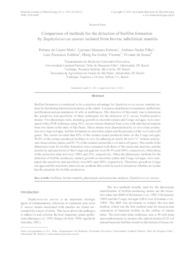Comparison of methods for the detection of biofilm formation by Staphylococcus aureus isolated from bovine subclinical mastitis.
Comparison of methods for the detection of biofilm formation by Staphylococcus aureus isolated from bovine subclinical mastitis.
Author(s): MELO, P. de C.; FERREIRA, L. M.; NADER FILHO, A.; ZAFALON, L. F.; VICENTE, H. I. G.; SOUZA, V. de
Summary: Biofilm formation is considered to be a selective advantage for Staphylococcus aureus mastitis isolates by facilitating bacterial persistence in the udder. It requires attachment to mammary epithelium, proliferation and accumulation of cells in multilayers. The objective of this study was to determine the sensitivity and specificity of three techniques for the detection of S. aureus biofilm-positive strains. Two phenotypic tests, including growth on microtitre plates and Congo red agar, were compared with a PCR technique using 94 S. aureus strains obtained from cows with subclinical mastitis from two farms in the state of São Paulo. These strains were characterised by in vitro slime production on Congo red agar, biofilm formation on microtitre plates and the presence of the icaA and icaD genes. The results revealed that 85% of the isolates tested produced slime on the Congo red agar, 98.9% of the isolates produced biofilms in vitro by adhering to sterile 96-well "U" bottom polystyrene tissue culture plates, and 95.7% of the isolates carried the icaA and icaD genes. The results of the phenotypic tests for biofilm formation were compared with those of the molecular analysis, and the sensitivity and specificity of the Congo red agar test were 88.9% and 100%, respectively, while those of the microtitre plate test were 100% and 25%, respectively. When the phenotypic methods for the detection of biofilm producers, namely growth on microtitre plates and Congo red agar, were compared, the sensitivity and specificity were 86% and 100%, respectively. Therefore, growth on Congo red agar and the microtitre plate test are methods that could be used to determine whether an isolate has the potential for biofilm production.
Publication year: 2013
Types of publication: Journal article
Observation
Some of Embrapa's publications are published as ePub files. To read them, use or download one of the following free software options to your computer or mobile device. Android: Google Play Books; IOS: iBooks; Windows and Linux: Calibre.
Access other publications
Access the Agricultural Research Database (BDPA) to consult Embrapa's full library collection and records.
Visit Embrapa Bookstore to purchase books and other publications sold by Embrapa.

